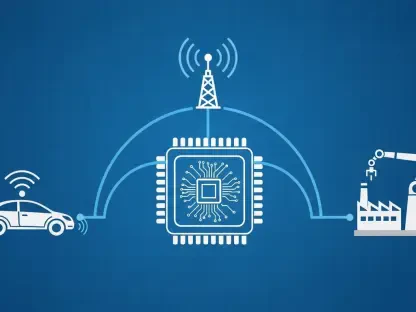Imagine a world where telecom networks operate with such precision that disruptions are predicted and resolved before customers even notice an issue, a reality that is no longer a distant dream but a tangible outcome as artificial intelligence (AI) integrates into the telecommunications sector at an unprecedented pace. According to a recent report by McKinsey, over 60% of global telecom operators have already adopted AI solutions to enhance operational efficiency. This transformative technology is redefining how telecom companies manage networks, interact with customers, and streamline processes in today’s fast-paced digital landscape. This analysis dives deep into the rise of AI in telecom operations, explores real-world applications, shares expert insights, and examines future prospects along with key takeaways for industry stakeholders.
The Rise of AI in Telecom Operations
Growth Trends and Adoption Statistics
The telecom industry’s embrace of AI is accelerating, driven by the need for automation and enhanced service delivery. Research from Gartner indicates that AI adoption in telecom has surged by 35% since 2025, with projections estimating a market value of $11 billion by 2027 for AI-driven telecom solutions. This growth is fueled by substantial investments in AI tools for network optimization, customer support chatbots, and predictive analytics. Telecom operators are prioritizing these technologies to reduce operational costs and improve response times in an increasingly competitive market.
Globally, regions like North America and Europe lead in AI integration, with companies in these areas allocating significant budgets to machine learning and data analytics. In contrast, emerging markets in Asia-Pacific are catching up rapidly, focusing on AI to manage vast subscriber bases. The trend underscores a universal shift among telecom providers toward automation as a core strategy, positioning AI as an indispensable asset for maintaining a competitive edge.
These statistics highlight a broader movement where AI is not merely an add-on but a fundamental component of telecom infrastructure. Operators are increasingly relying on intelligent systems to handle complex tasks, from traffic management to fraud detection, reflecting a transformative shift in operational paradigms across the sector.
Real-World Impact and Implementation
A prime example of AI’s transformative power in telecom is O2 Telefónica’s groundbreaking project in Germany, known as the Large Telco Model. Developed in collaboration with Tech Mahindra and Nvidia, this generative AI initiative leverages advanced algorithms to enhance network operations. By integrating structured data, such as network alarms, with unstructured data like logs and images, the model improves fault detection, coordinates technician responses, and boosts service reliability for millions of users.
The practical implications of this technology are profound, as it enables faster identification of network disruptions and streamlines field operations. Showcased at Nvidia’s GTC conference earlier this year, the Large Telco Model positions O2 Telefónica as a pioneer in AI adoption within Germany’s telecom landscape. This early implementation demonstrates how AI can address longstanding operational challenges with innovative, data-driven solutions.
Beyond fault management, the project signifies a broader push toward autonomous systems that minimize human intervention. Such advancements not only elevate service quality but also set a benchmark for other operators looking to modernize their infrastructure, illustrating the tangible benefits of AI in real-world telecom scenarios.
Industry Perspectives on AI-Driven Transformation
The potential of AI to revolutionize telecom operations is echoed by industry leaders who champion its role in automation. Mircea Anghel, Director of Service Operations at O2 Telefónica, has emphasized the impact of the Large Telco Model in enhancing decision-making. According to Anghel, the technology introduces greater autonomy to operations teams by leveraging data-driven insights, thereby improving network reliability and efficiency in unprecedented ways.
Similarly, Amol Phadke, Chief Transformation Officer at Tech Mahindra, has highlighted the critical importance of autonomous operations for telecom providers. Phadke underscores the value of collaborative innovation, noting that partnerships like the one with O2 Telefónica and Nvidia are essential for delivering measurable outcomes. This shared vision reflects a collective commitment to harnessing AI as a tool for tackling complex operational hurdles.
These perspectives reveal a consensus among industry experts on AI’s role as a catalyst for change. The focus on collaboration and data-driven strategies points to a future where telecom services are not only more efficient but also more responsive to customer needs, driven by a unified push for technological advancement.
The Future of AI in Telecom Operations
Looking ahead, AI promises to usher in fully autonomous networks capable of self-monitoring and self-repairing without human oversight. Innovations like predictive maintenance could foresee equipment failures before they occur, ensuring uninterrupted service and slashing maintenance costs. Such advancements hold the potential to redefine service quality, making outages a rarity while optimizing resource allocation for telecom operators.
However, this bright future comes with challenges, including concerns over data privacy as AI systems handle vast amounts of sensitive information. Integration complexities also pose hurdles, as legacy systems must align with cutting-edge technologies. Addressing these issues will require robust security frameworks and strategic planning to ensure seamless adoption across diverse operational environments.
Moreover, AI’s role extends beyond current applications to support emerging technologies like 5G and the Internet of Things (IoT). Strategic moves, such as O2 Telefónica’s partnership with AWS for 5G core deployment, complement these trends by enhancing infrastructure capabilities. The convergence of AI with these technologies signals a broader industry transformation, positioning telecom operators to meet the demands of a hyper-connected world.
Key Takeaways and Call to Action
Reflecting on the journey, it becomes evident that AI holds transformative potential for telecom operations, with initiatives like O2 Telefónica’s Large Telco Model setting a powerful precedent through innovative fault detection and automation. Industry leaders consistently advocate for AI as a cornerstone of operational efficiency, pointing toward a future dominated by autonomous systems. This analysis captures the momentum of AI adoption, revealing its capacity to address both immediate needs and long-term strategic goals.
As the industry evolves, the importance of staying ahead in AI adoption grows clearer, driven by the need to meet rising customer expectations and complex operational demands. The path forward demands proactive investment in AI solutions to maintain competitiveness in a rapidly changing landscape.
Looking to the next steps, telecom operators, technologists, and stakeholders are urged to prioritize collaborative partnerships and innovative technologies to shape the industry’s trajectory. By committing to these efforts, the sector can build on past successes to create a future where AI not only enhances efficiency but also redefines customer experiences on a global scale.









